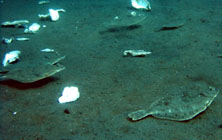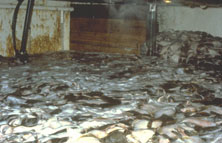Rock Sole (Lepidopsetta bilineata (South) and L. polyxystra (North))
- Rock sole has recovered from overfishing by foreign fleets in the 1960s and is now extremely abundant.
- The fishery for rock sole is regulated by a series of management measures developed by the North Pacific Fishery Management Council.
- Rock sole is an excellent source of low-fat protein, calcium, and other important nutrients. For more on nutrition, see Nutrition Facts. (USDA)
- Rock sole is part of an important trawl fishery in the Bering Sea and Gulf of Alaska. The United States accounts for the majority of the worldwide harvest of this fish.
|
 |
 |
 |
 |
| Nutrition Facts |
| Servings 1 |
| Serving Weight
100g |
 |
| Amount Per Serving |
 |
| Calories 91 |
 |
| Total Fat |
1.19 g |
 |
| Total Saturated Fatty Acids |
0.283 g |
 |
| Carbohydrate |
0 g |
| Sugars |
0 g |
| Total Dietary
Fiber |
0 g |
 |
| Cholesterol |
48 mg |
 |
| Selenium |
32.7 mcg |
 |
| Sodium |
81 mg |
 |
| Protein |
18.84 g |
 |
|
 |
 Cryptic coloration of both species of rock sole helps them blend in with their environment. Cryptic coloration of both species of rock sole helps them blend in with their environment.
|
 |
Did you know?
Rock sole are the target of a high value roe fishery, which accounts for the majority of the annual catch in the Bering Sea/Aleutian Islands area. Roe fisheries target fish for their eggs.
Rock sole is sometimes called roughback because of the rough scales on its back.
The rock sole's coloring and movement on the sea floor often confuses predators.
|
|
| |
 |
|
Rock sole swim skimming the sea floor to avoid being seen by a potential predator.
|
 |
|
The hold of a commercial fishing vessel filling up with sole.
|
|
Sustainability Status
Biomass: The biomass of rock sole in the Bering Sea-Aleutian Islands area is very high, at twice the biomass needed to support maximum sustainable yield. The most current biomass estimates of northern and southern rock sole in the Gulf of Alaska are 102,303 metric tons and 161,617 metric tons, respectively. The catch quota for the shallow water flatfish complex (19,972 metric tons) is well below these biomass estimates. There are no estimates of rock sole biomass off the West Coast.
Overfishing: No
Overfished: No
Fishing and habitat: Rock sole are caught by bottom trawls over sand and mud habitats, which are not as likely to be damaged by trawling as other habitats.
Bycatch: Pacific halibut, male rock sole, immature female rock sole, Pollock, arrowtooth flounder, pacific cod are caught incidentally in the BSAI fishery for rock sole. In the GOA fishery, the majority of the bycatch are other species in the shallow water flatfish complex and arrowtooth flounder. There is no bycatch associated with rock sole catches off the West Coast because they are an incidentally caught species themselves.
Aquaculture: There is currently no commercial aquaculture of rock sole in the U.S.
|
Science and Management
There are two species of rock sole that are managed within the U.S. EEZ, a northern species and a southern species. The northern species of rock sole (L. polyxystra) is more common in the Bering Sea and Aleutian Islands (BSAI) and is managed by the North Pacific Fishery Management Council (NPFMC) as part of the Groundfish of the BSAI Fishery Management Plan (FMP). This FMP controls the fishery through permits and limited entry, catch quotas, seasons, in-season adjustments, gear restrictions, closed waters, bycatch limits and rates, allocations, regulatory areas, record keeping and reporting requirements, and observer monitoring. Harvests are constrained by halibut and crab bycatch limits. In 2003, Amendment 49 to the FMP required that all rock sole caught must be retained.
Both species of rock sole occur in the Gulf of Alaska (GOA). They are managed as part of the shallow-water flatfish group in the Groundfish of the GOA FMP by the NPFMC. The plan controls the fishery in the GOA with the same measures as the BSAI management plan. In general, flatfish in the GOA are lightly to moderately harvested, and fishing is severely constrained by halibut bycatch limits.
The southern species of rock sole is also found off the West Coast and is included in the Pacific Fishery Management Council's Pacific Coast Groundfish FMP. It is only caught incidentally in other fisheries and is managed as part of the "Other Flatfish" complex, which includes all flatfish species that are not assessed.
|
Life History and Habitat
Life history, including information on the habitat, growth, feeding, and reproduction of a species, is important because it affects how a fishery is managed.
- Geographic range: The northern species of rock sole, L. polyxystra, is found from Puget Sound to the Kuril Islands (in the Western Pacific north of Japan); the southern species, L. bilineata, is found from Baja California to the far southeasterly extreme of the Bering Sea.
- Habitat: Larvae are pelagic and primarily found in the upper 100 feet of the water column. Juveniles move into deeper waters as they grow larger. Juveniles and adults live on the bottom and are found primarily in shallow water bays over the continental shelf as deep as 2,400 feet (but are uncommon below 985 feet). Adults and juveniles prefer sandy or gravel bottoms on the coast of the contiguous U.S. and also like steep rock slopes in Puget Sound. Some rock sole also prefer soft bottoms.
- Life span: Rock sole can live 15 to 20 years.
- Food: Larvae eat plankton. Juveniles and adults are carnivorous. Juveniles feed on mobile prey such as small crustaceans. Adults feed on more sedentary foods, such as polychaete and echiuroid worms, mollusks, echinoderms, benthic fishes, and tunicates.
- Growth rate: Moderately slow. After 2 to 3 years, females grow faster than males and reach a larger average size. Growth of both sexes decreases after 8 years of age.
- Maximum size: Up to 2 feet.
- Reaches reproductive maturity: Rock soles mature in 4 to 7 years.
- Reproduction: Eggs are demersal and stick to the surface on which they are laid. They hatch in anywhere from 6 to 25 days, depending on temperature.
- Spawning season: Rock sole spawn in winter through early spring, depending on location.
- Spawning grounds: Rock sole spawn over a variety of surfaces, from rocky banks to sand and mud. In Puget Sound, spawning occurs in shallow water.
- Migrations: Rock sole are relatively sedentary. Larvae migrate daily following abundances in prey. Immature rock sole reside in shallow waters and move to shallower waters in coastal areas in the spring and summer. Juveniles move into deeper water as they grow larger. Adults migrate to deeper waters in the winter to spawn then back to feeding grounds in shallow waters over the continental shelf in the summer.
- Predators: Larvae are eaten by larger fishes, including other rock sole, and perhaps sea birds. Juveniles are eaten by larger fishes, also including rock sole. Adults are eaten by sharks, marine mammals, and larger fishes.
- Commercial or recreational interest: Commercial
- Distinguishing characteristics: The rock sole is a flatfish. Most flatfish have both eyes on one side of their head. The southern rock sole's blind (non-eyed) side is white with glossy highlights, but the northern rock sole's blind side is creamy white, with no glossy highlights.
|
Role in the Ecosystem
The diet of adult rock sole consists of fish (40%) polychaetes (27%), clam siphons (10%). As with most flatfish, their diet consists mainly of other bottom organisms. Predators of juvenile rock sole are Alaska pollock, Pacific cod, yellowfin sole, skates, and Pacific halibut.
|
Additional Information
Market names: Sole or Flounder
Vernacular names: Rock Flounder, Twolined Flounder, Whitebellied Flounder
|
Biomass
 Biomass refers to the amount of rock sole in the ocean. Scientists cannot collect and weigh every single fish to determine biomass, so they use mathematical models to estimate it instead. These biomass estimates can help determine if a stock is being fished too heavily or if it may be able to tolerate more fishing pressure. Managers can then make appropriate changes in the regulations of the fishery. Biomass refers to the amount of rock sole in the ocean. Scientists cannot collect and weigh every single fish to determine biomass, so they use mathematical models to estimate it instead. These biomass estimates can help determine if a stock is being fished too heavily or if it may be able to tolerate more fishing pressure. Managers can then make appropriate changes in the regulations of the fishery.
In the Bering Sea and Aleutian Islands (BSAI) area, rock sole biomass levels were low from the mid-1970s through 1982. Due to above-average recruitment and light exploitation, biomass sharply increased to over 1.8 million tons by 1995. Biomass since declined to about 1.5 million in 2003 then increased to over 1.7 million tons in 2008. The stock size is expected to increase further in the near future due to strong recruitment from the rock sole born in 2001 through 2003.
In the Gulf of Alaska, northern and southern rock sole have generally increased in biomass through 2007. Rock sole are not assessed of the West Coast of the U.S.
Note: In the graph, BSAI biomass includes rock sole age 2 and older. GOA biomass is from NMFS bottom-trawl surveys, currently conducted every two years.
Landings
 Landings refer to the amount of catch that is brought to land. In the Bering Sea and Aleutian Islands (BSAI) area, catches of rock sole increased from an annual average of 7,000 tons in the 1960s to 30,000 tons between 1970 and 1975. Domestic catches from 1989 to 2007 have averaged 47,600 tons annually. The 2008 catch of 51,275 tons was only 17% of the allowable biological catch of 300,700 tons; thus, rock sole remain lightly harvested in the BSAI. Landings refer to the amount of catch that is brought to land. In the Bering Sea and Aleutian Islands (BSAI) area, catches of rock sole increased from an annual average of 7,000 tons in the 1960s to 30,000 tons between 1970 and 1975. Domestic catches from 1989 to 2007 have averaged 47,600 tons annually. The 2008 catch of 51,275 tons was only 17% of the allowable biological catch of 300,700 tons; thus, rock sole remain lightly harvested in the BSAI.
Prior to 2001, rock sole was categorized as one species in the Gulf of Alaska (GOA). Since then, data for northern and southern rock sole have been reported separately. From 1991 to 2000, rock sole catch ranged from 1,823 metric tons in 1999 to 7,987 metric tons in 1993. Northern rock sole catch in the GOA has ranged from 453 metric tons in 2004 to 4,330 metric tons in 2006. Southern rock sole catch in the GOA has ranged from 1,468 metric tons in 2004 to 4,260 metric tons in 2007. Rock sole are lightly to moderately exploited, and the fishery is likely to continue to be limited by bycatch limits for Pacific halibut.
Landings off the West Coast are minimal, as rock sole is only caught incidentally in other fisheries. They are not shown in the graph.
Note: Catch, not landings, from the BSAI and GOA areas are shown in the graph. Catch includes rock sole that were not retained. In the BSAI from 1987 to 2000, rock sole was discarded more than it was retained; however, in the past five years, there has been increased utilization of the catch, with as high as 78% retained in 2006. In the GOA, 87% to 94% of shallow-water flatfish have been retained from 2001 to 2007.
Biomass and Landings
 Are landings and biomass related? Landings are dependent on biomass, management measures in the fishery, and fishing effort.
Are landings and biomass related? Landings are dependent on biomass, management measures in the fishery, and fishing effort.
Data sources:
Biomass and landings from 2008 BSAI Northern Rock Sole Stock Assessment, 2008 Gulf of Alaska Flatfish Stock Assessment
|
Important Dates
1963 – Rock sole are harvested by Japanese and Soviet vessels in the BSAI
1972 – Foreign catch peaks in BSAI at 61,000 metric tons
Mid-1970s-1982 – BSAI biomass is at low levels
1978 – GOA FMP is implemented
1980 – Joint-venture operations begin in BSAI
1982 – BSAI FMP is implemented
1986 – Foreign fishing ceases in the GOA; joint-venture operations begin to account for the majority of the catch
1987 – GOA flatfish catch increases nearly four-fold to 10,000 metric tons
1988 – BSAI catches increase to 86,000 metric tons
1988 – GOA fishery is fully domestic
1990 – Fishery in BSAI is fully domestic
1995 – Biomass in BSAI increases to almost 1.9 million tons
2003 – BSAI biomass decreases to 1.5 million tons
2008 – BSAI biomass increases to 1.75 million tons; catch is only 17% of the allowable biological catch
|
Notes and Links
General Information:
Groundfish of the Bering Sea and Aleutian Islands Area: Species Profiles
Groundfish of the Gulf of Alaska: a Species Profile
AFSC Research - Rock Sole
Fishery Management:
Pacific Coast Groundfish Fishery Management Plan
FMP for Groundfish of the Bering Sea and Aleutian Islands and Appendix
FMP for Groundfish of the Gulf of Alaska and Appendices
Stock Assessments:
2008 BSAI Northern Rock Sole Stock Assessment
2008 Gulf of Alaska Flatfish Stock Assessment
|
| |
|



